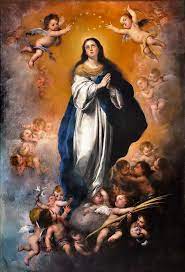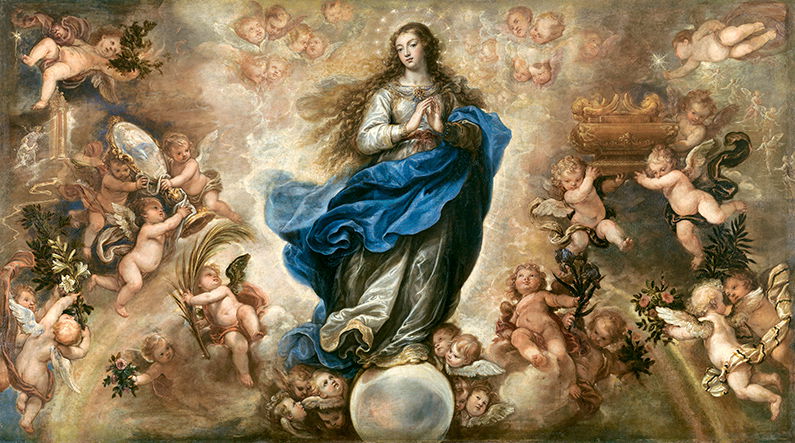THE IMMACULATE CONCEPTION OF MARY

POPE JOHN PAUL II GENERAL AUDIENCE
Wednesday, June 12, 1996
The Dogmatic Definition of the Privilege of the Immaculate Conception
(Reading: Chapter 1 of St. Luke's Gospel, verses 46-19)
1. The conviction that Mary was preserved from every stain of sin from the moment of her conception, to the point that she was called a saint, gradually gained ground in the liturgy and in theology. This development gave rise, at the beginning of the 19th century, to a movement of petitions in favor of a dogmatic definition of the privilege of the Immaculate Conception.
Pope Pius IX, towards the middle of that century, wishing to meet this demand, after having consulted theologians, asked the bishops for their opinion on the opportunity and the possibility of such a definition, almost summoning a council in writing. The result was significant: the vast majority of the 604 bishops responded positively to the question. After such a broad consultation, which underscored the concern of my venerable predecessor to express, in the definition of dogma, the faith of the Church, the drafting of the document began with the same care.
The special commission of theologians, created by Pius IX for the certification of revealed doctrine, attributed an essential role to ecclesial praxis. And this criterion influenced the formulation of the dogma, which gave more importance to the expressions of what was lived in the Church, of the faith and worship of the Christian people, than to scholastic determinations.
Finally, in 1854, Pius IX, with the bull Ineffabilis, solemnly proclaimed the dogma of the Immaculate Conception: ".... We declare, proclaim and define that the doctrine which holds that the Blessed Virgin Mary was preserved immune from every stain of original guilt at the first moment of her conception by the singular grace and privilege of Almighty God, in view of the merits of Christ Jesus, Savior of the human race, is revealed by God and must therefore be firmly and constantly believed by all the faithful" (DS, 2.803).
2. The proclamation of the dogma of the Immaculate Conception expresses the essential datum of faith. Pope Alexander VII, in the Bull Sollicitudo of 1661, spoke of the preservation of Mary's soul "at the first moment of her creation and infusion into the body" (DS, 2.017).
The definition of Pius IX, on the contrary, dispenses with all explanations about the mode of infusion of the soul into the body and attributes to the person of Mary, at the first instant of her conception, being preserved from every stain of original guilt. The immunity "from every stain of original guilt" implies as a positive consequence the complete immunity from all sin, and the proclamation of Mary's perfect holiness, a doctrine to which the dogmatic definition makes a fundamental contribution. In fact, the negative formulation of the Marian privilege, conditioned by the previous controversies that developed in the West about original guilt, must always be completed with the positive enunciation of Mary's holiness, underlined more explicitly in the Eastern tradition.
Pius IX's definition refers only to immunity from original sin and does not explicitly imply immunity from concupiscence. However, the complete preservation of Mary from every stain of sin has as a consequence in her also immunity from concupiscence, a disordered tendency which, according to the Council of Trent, proceeds from sin and inclines to sin (DS, 1.515).
3. This preservation from original sin, granted "by the singular grace and privilege of the omnipotent God," constitutes a completely gratuitous divine favor, which Mary obtained from the first moment of her existence.
The dogmatic definition does not affirm that this singular privilege is unique, but it implies it. The affirmation of this uniqueness is, on the other hand, explicitly stated in the encyclical Fulgens corona of 1953, in which Pope Pius XII speaks of "a very singular privilege that has never been granted to any other person" (AAS 45 [1953] 580), thus excluding the possibility, held by some, but with little foundation, of attributing it also to St. Joseph.
The Virgin Mother received the singular grace of the Immaculate Conception "in view of the merits of Christ Jesus, Savior of the human race," that is, of his universal redemptive action. In the text of the dogmatic definition it is not expressly stated that Mary was redeemed, but the Bull Ineffabilis itself states elsewhere that "she was redeemed in the most sublime way". This is the extraordinary truth: Christ was the redeemer of his Mother and exercised his redemptive action in her "in the most perfect way" (Fulgens corona, AAS 45 [1953] 581), already from the first moment of her existence. Vatican II proclaimed that the Church "admires and extols in Mary the most splendid fruit of redemption" (Sacrosanctum Concilium, 103).
4. This doctrine, solemnly proclaimed, is expressly qualified as "doctrine revealed by God". Pope Pius IX adds that it must be "firmly and constantly believed by all the faithful. Consequently, whoever does not make it his own, or holds an opinion contrary to it, "is shipwrecked in the faith" and "separates himself from Catholic unity". In proclaiming the truth of this dogma of the Immaculate Conception, my venerable Predecessor was aware that he was exercising his infallible teaching power as universal Pastor of the Church, which a few years later would be solemnly defined during the First Vatican Council. Thus he was carrying out his infallible magisterium as a service to the faith of the people of God; and it is significant that this happened in defining Mary's privilege.
Greetings
Dear brothers and sisters, I now cordially greet the Spanish-speaking pilgrims present at this Audience, in particular the Franciscan Religious of Latin America; the Missionary Friars of the Sick Poor and other pilgrims from Spain; the pilgrims from Mexico, El Salvador, Colombia and Argentina. May Mary Immaculate always accompany and protect your journey in this life towards the eternal homeland. With these wishes I affectionately impart to you and your families my Apostolic Blessing.
Development of the dogma of the Immaculate Conception
Mary is "full of grace", from the Greek "kecharitomene" which means a particular abundance of grace, a supernatural state in which the soul is united with God Himself. Mary as the Woman expected in the Protoevangelium (Gen. 3:15) stands at enmity with the serpent because she is full of grace.
Devotions to the Immaculate Virgin Mary are numerous, and among her devotees saints such as St. Francis of Assisi and St. Augustine stand out. In addition, devotion to the Immaculate Conception of Mary was brought to the entire Western Church by Pope Sixtus IV in 1483.
The path to the dogmatic definition of the Immaculate Conception of Mary was traced by the Franciscan Duns Scotto. It is said that when he found himself in front of a statue of the Virgin Mary he made this request: "Dignare me laudare te: Virgo Sacrata" (O Sacrosanct Virgin give me the proper words to speak well of You) and then the Franciscan made these questions:
1. Was it in God's best interest that his Mother be born without stain of original sin?Yes, it was in God's best interest that his Mother be born without any stain. This is the most honorable thing for Him.
2. Could God cause his Mother to be born without stain of original sin?Yes, God can do all things, and therefore He could cause His Mother to be born without stain: Immaculate.
3. What it is convenient for God to do, does he do it, or does he not do it?All answered: What God sees fit to do, what God sees fit to do, He does.
Then Scotto exclaimed: Then
1. It was better for God that his Mother should be Immaculate: that is, without stain of original sin.
2. God could make his Mother to be born Immaculate: without stain.
3. Therefore: God caused Mary to be born without stain of original sin. Because when God knows that something is better to do, He does it.
The Virgin Mary is Immaculate thanks to Christ her son, since He was to be born from her womb, God made her Immaculate so that she would have a pure womb in which to be incarnated. This shows how Jesus is Savior in God's keeping with Mary and the omnipotence of the Father is revealed as the cause of this gift. Thus, Mary never bowed to concupiscence and her greatness shows that as a human being she was free but never offended God and thus did not lose the enormous grace He bestowed on her.
The Immaculate Virgin Mary shows us the need to have a pure heart so that the Lord Jesus can live within us and from there Salvation can be born. And consecrating ourselves to her leads us to make our prayer the means by which Jesus Christ is fully revealed to us and leads us to the way by which we will be filled by the Holy Spirit.


